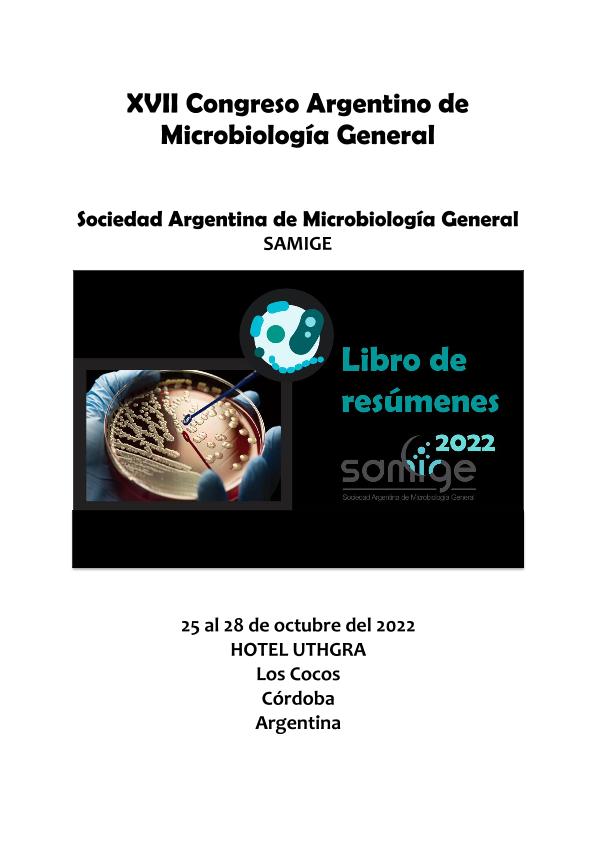Evento
Fertigation with enriched vinasse: a study of the impact on productive soil in the short term
Torres, Mariela Analía ; Lacosegliaz, Mariano José
; Lacosegliaz, Mariano José ; Raimondo, Enzo Emanuel
; Raimondo, Enzo Emanuel ; Angelicola, María Virginia
; Angelicola, María Virginia ; Pajot, Hipolito Fernando
; Pajot, Hipolito Fernando ; Nieto Peñalver, Carlos Gabriel
; Nieto Peñalver, Carlos Gabriel
 ; Lacosegliaz, Mariano José
; Lacosegliaz, Mariano José ; Raimondo, Enzo Emanuel
; Raimondo, Enzo Emanuel ; Angelicola, María Virginia
; Angelicola, María Virginia ; Pajot, Hipolito Fernando
; Pajot, Hipolito Fernando ; Nieto Peñalver, Carlos Gabriel
; Nieto Peñalver, Carlos Gabriel
Tipo del evento:
Congreso
Nombre del evento:
XVIII Congreso Argentino de Microbiología General
Fecha del evento:
25/10/2022
Institución Organizadora:
Sociedad Argentina de Microbiología General;
Título del Libro:
XVIII Congreso Argentino de Microbiología General
Editorial:
Sociedad Argentina de Microbiología General
Idioma:
Inglés
Clasificación temática:
Resumen
Vinasse, a byproduct from the sugar-alcohol industry, is a brown effluent with an acid pH, highchemical and biological oxygen demand and a high content of mineral salts. 13 liters of pollutingvinasse are generated from every liter of ethanol. Legislation allows the use of vinasse to irrigatesugarcane crops or non-productive soils. This activity, known as fertigation, can enrich the soilproviding minerals, organic matter and important elements including nitrogen and phosphorus.However, uncontrolled fertigation has detrimental effects: salinization, acidification and alterationof the soil microbiota. According to the circular economy, it is important to consider new strategiesto increase agricultural production, to diversify industrial production and to reduce theenvironmental impact. Considering this model, we propose the use vinasse as culture mediumfor the growth of microorganisms of agricultural relevance. The objective of this work was todetermine the impact in short term in the soil of fertigation with spent vinasse used as a mediumfor culturing bioinoculants. 55% vinasse was used for the growth of Trichoderma harzianum MT2(T-MT2) alone and in co-culture with Pseudomonas capeferrum WCS358 (P-WCS358) orRhizobium sp. N21.2 (R-N21.2). Subsequently, the cultures were gauze-filtered and the residualvinasses were used to irrigate soil not previously fertigated. Irrigation was repeated twice in theamount and frequency recommended by EEAOC. After 21 days, the physical-chemical andmicrobiological characteristics of the treated soil were determined. The results showed pH andtoxicity identical when irrigated with water, control vinasse and residual vinasse. Increases inconductivity and salinity were observed when irrigated with control and residual vinasse. Catalaseactivity and FDA hydrolysis showed no variations, while urease showed large differences betweenwater and vinasse; treatment with residual vinasse showed intermediate values. Totalheterotrophic counts with water showed the lowest values. In the case of vinasse and residualvinasse, slight increases were observed, though only significant with residual vinasse from the TMT2+R-N21.2 culture. Finally, the average metabolic diversity (BIOLOG EcoPlates) with controland residual vinasse from T-MT2+R-N21.2 presented the highest values. In opposite, the soilirrigated with water produced the lowest values. In general, the soils irrigated with residualvinasses enriched with microorganisms showed similar physico-chemical characteristics to thevinasse irrigation and better microbiological characteristics than the water irrigation. These resultsindicate that fertigation with vinasse utilized for the culture of agronomically importantmicroorganisms does not damage the soil properties in short terms. At the same time, they giveadded value to a problematic effluent obtaining at the same time a new product that could beapplied to the soil in an environmentally friendly way.
Palabras clave:
CIRCULAR ECONOMY
,
VINASSE
,
INOCULANT
,
SOIL
,
FERTIRRIGATION
Archivos asociados
Licencia
Identificadores
Colecciones
Eventos(PROIMI)
Eventos de PLANTA PILOTO DE PROC.IND.MICROBIOLOGICOS (I)
Eventos de PLANTA PILOTO DE PROC.IND.MICROBIOLOGICOS (I)
Citación
Fertigation with enriched vinasse: a study of the impact on productive soil in the short term; XVIII Congreso Argentino de Microbiología General; Los Cocos; Argentina; 2022; 153-154
Compartir



